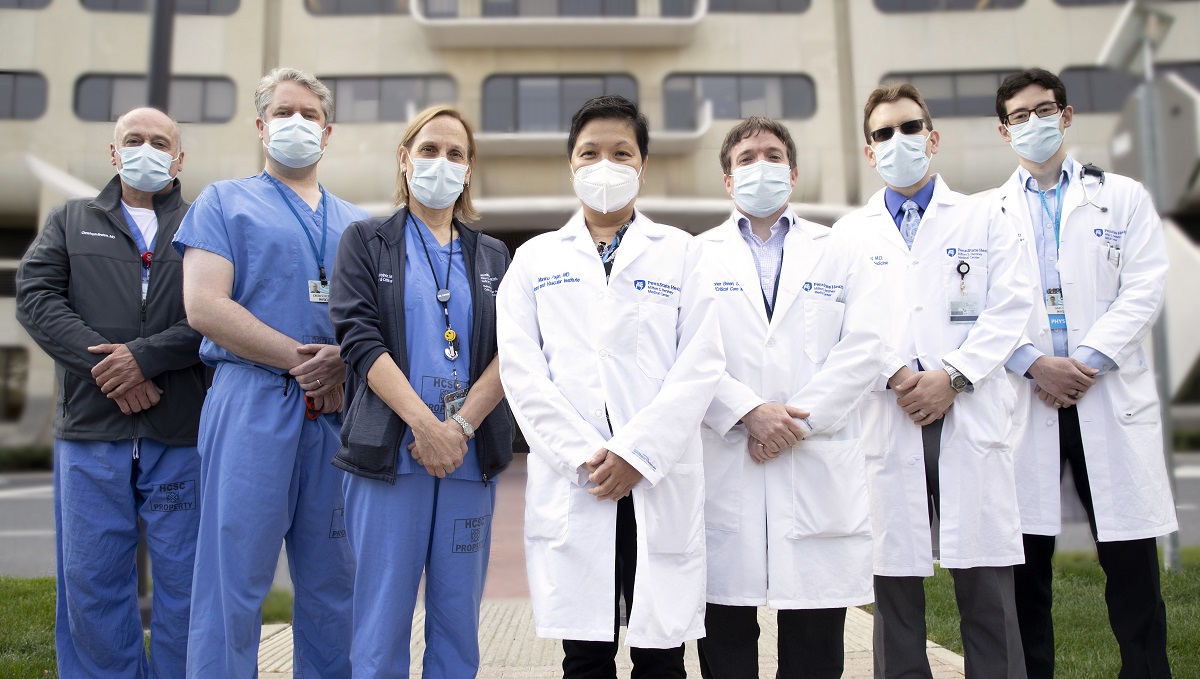Evidence-based protocols help provide faster care for pulmonary embolism

A blood clot that blocks an artery in the lung — called a pulmonary embolism — can be life-threatening. But no two pulmonary emboli are alike. Thanks to two new protocols developed by a clinical team, caregivers at Hershey Medical Center can now quickly and more accurately identify their severity and deliver the most appropriate treatment.
Cardiothoracic surgeon Dr. Marilou Page chaired the quality improvement project, which began 18 months ago and included team members from cardiac surgery, pulmonary critical care, interventional radiology, interventional cardiology, emergency department physicians and hospitalists. It also included specialists in extracorporeal membrane oxygenation (ECMO), a cardiovascular treatment that pumps and oxygenates a patient’s blood outside the body, which allows the heart and lung to rest.
“We determined, first of all, that all patients even suspected of having a pulmonary embolism should receive heparin (a blood thinner) as soon as possible unless the patient is allergic to it,” Page said.
From there, caregivers at Hershey Medical Center use the newly developed Penn State Unified Protocol for PE Treatment (PUPPET). It walks them through PE diagnosis and offers additional treatment pathways which, depending on the type of PE, may include:
- Use of the clot-busting medication tPA
- Use of direct oral anticoagulant medications (such as Xarelto or Eliquis)
- Consultation with cardiovascular interventional radiology specialists
- Surgery to insert an inferior vena cava filter that can trap large blood clots and restrict their movement
- Consultation with ECMO = specialists and potential ECMO treatment
After creating PUPPET, the team developed a second protocol that created a Pulmonary Embolism Response Team (PERT). Per the PERT protocol, any Hershey Medical Center caregiver of a patient with PE can call Patient Logistics at x1710 and request to speak with a pulmonary care fellow. Based on that discussion, the fellow can then activate the PERT team by pager and consult with them immediately on a conference call. The PERT process launched on April 9.
“By giving caregivers just one phone number to call and get a PE consult, we’re expediting care,” said Dr. Margaret Wojnar, a pulmonologist and Director of the Medical Intensive Care Unit, who served on the team.
To create the protocols, the team reviewed five years’ worth of data covering roughly 4,500 Hershey Medical Center patients with PE. They also reviewed literature to find evidence-based best practices for the implementation of PERT teams. The team’s ultimate goals are to enhance the quality of patient care, improve patient survival and reduce the length of time patients with PE need to spend in the hospital.
“The longer it takes to treat a PE, the worse a patient’s condition may get; they can crash very quickly” Wojnar said. “That’s why I’m so thankful to the team that created these protocols, because they will help our team identify and treat PE faster.”
Penn State Health physicians involved in creating the protocols, in addition to Page and Wojnar, included Dr. David Chu, Dr. Chris Breen, Dr. Frank Lynch, Dr. Ian Ross, Dr. Shane Kinard, Dr. Christoph Brehm, Dr. Jordan Schooler, Dr. Chad Zack, Dr. Colleen Rafferty and Dr. Jeff Cope
If you're having trouble accessing this content, or would like it in another format, please email Penn State Health Marketing & Communications.
